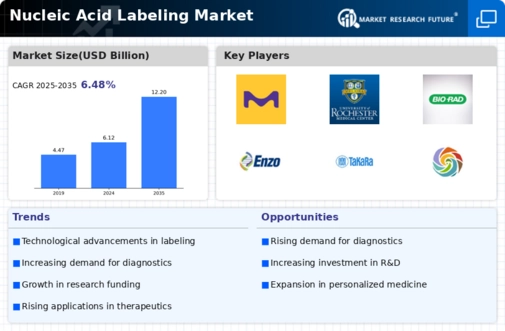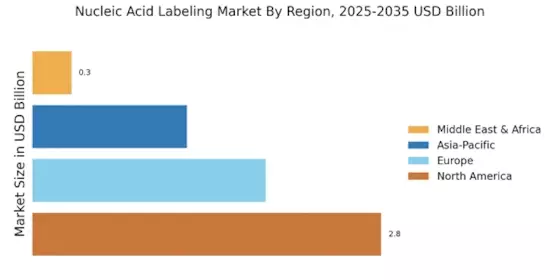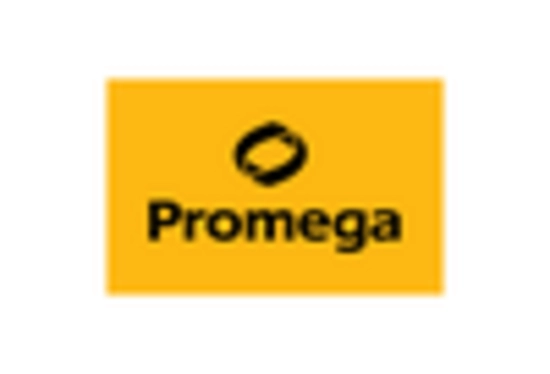Growing Applications in Diagnostics
The Nucleic Acid Labeling Market is witnessing a growing application of labeling techniques in diagnostics. The rise in infectious diseases and genetic disorders has led to an increased demand for accurate diagnostic tools that utilize nucleic acid labeling. Techniques such as in situ hybridization and polymerase chain reaction are becoming standard practices in clinical laboratories. The market for diagnostic applications is projected to account for a significant share, with estimates indicating a growth rate of around 8% annually. This trend underscores the critical role of nucleic acid labeling in enhancing the accuracy and reliability of diagnostic tests, thereby improving patient outcomes.
Expansion of Research Collaborations
The Nucleic Acid Labeling Market is benefiting from the expansion of research collaborations among academic institutions, biotechnology firms, and pharmaceutical companies. These partnerships are fostering innovation and accelerating the development of new labeling techniques and applications. Collaborative research initiatives are increasingly focusing on the use of nucleic acid labeling in various fields, including genomics, proteomics, and molecular diagnostics. This collaborative environment is likely to enhance the availability of advanced labeling solutions, thereby driving market growth. The increasing number of joint ventures and research grants is indicative of a robust ecosystem that supports the advancement of nucleic acid labeling technologies.
Increased Funding for Genomic Research
The Nucleic Acid Labeling Market is experiencing a boost due to increased funding for genomic research initiatives. Governments and private organizations are allocating substantial resources to support research in genomics, which often relies on advanced nucleic acid labeling techniques. This influx of funding is facilitating the development of innovative labeling methods and expanding the scope of research projects. As a result, the market is likely to see a rise in demand for labeling products and services, with projections suggesting a potential market expansion of over 15% in the coming years. This trend reflects the growing recognition of the importance of nucleic acid labeling in advancing scientific knowledge and improving healthcare solutions.
Rising Demand for Personalized Medicine
The Nucleic Acid Labeling Market is significantly influenced by the rising demand for personalized medicine. As healthcare shifts towards more individualized treatment approaches, the need for precise and accurate nucleic acid labeling becomes paramount. This trend is particularly evident in oncology, where targeted therapies require detailed genetic profiling of tumors. The market is expected to witness substantial growth, with estimates suggesting an increase in market value to over 2 billion USD by 2026. This growth is fueled by the integration of nucleic acid labeling in diagnostic tests and therapeutic applications, enabling healthcare providers to tailor treatments based on genetic information.
Technological Advancements in Nucleic Acid Labeling
The Nucleic Acid Labeling Market is experiencing a surge in technological advancements that enhance the efficiency and accuracy of labeling techniques. Innovations such as next-generation sequencing and CRISPR technology are revolutionizing the way nucleic acids are labeled and analyzed. These advancements not only improve the sensitivity of detection methods but also reduce the time required for analysis. For instance, the introduction of fluorescent dyes and probes has enabled researchers to visualize nucleic acids with unprecedented clarity. As a result, the market is projected to grow at a compound annual growth rate of approximately 10% over the next five years, driven by the increasing adoption of these advanced technologies in both research and clinical settings.


















Leave a Comment